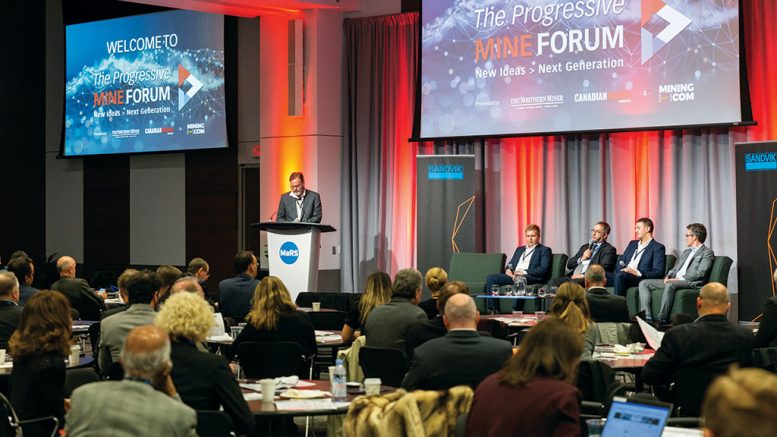Rising electric vehicle (EV) adoption is driving a massive transformation in lithium-ion battery production. “Back in 2015, there were three lithium-ion battery megafactories [built or in development] — we’re now up to 99,” says Andrew Miller, Benchmark Mineral Intelligence’s head of price assessment.
“We have seen a huge wave of companies enter this market, a lot in Asia, which is really the lithium-ion battery production hub,” says Miller, kicking off a panel discussion on battery metals in October 2019 at The Northern Miner’s Progressive Mine Forum in Toronto.
“While the rest of the supply chain maybe isn’t moving at the same pace, what’s happening downstream is worth keeping track of, to see where this market is going longer-term.”
Miller estimates total lithium-ion cell production will come in below 200 gigawatt hours (GWh) for 2019. As of January 2019, total production capacity in the pipeline over the coming decade (including projects producing, under construction and planned) totalled 1,550 GWh. By 2028, Miller estimates there will be 2,030 GWh in the production pipeline.
Looking upstream at the mining picture, four critical minerals (cobalt, graphite, lithium and nickel) will see demand growth from the battery sector if the 99 planned megafactories come online, he says.
Counting supply from existing operations and their expected growth, Miller forecasts the lithium market will move into deficit in 2022. Under a scenario where all projects under development today become producers, that deficit will arrive in 2027. Using the same assumptions, he says the cobalt market will be in deficit in 2020 or 2026, and a flake graphite deficit will emerge in 2022 or 2028.

Industry experts discuss trends in battery metals markets amid emerging EV technology. Moderator: Frik Els, executive editor, MINING.com Panelists (from left): Ryan Castilloux, managing director, Adamas Intelligence; Guy Bourassa, president and CEO, Nemaska Lithium; Andrew Miller, head of price assessments, Benchmark Mineral Intelligence; and Trent Mell, president and CEO, First Cobalt. Credit: George Matthew Photography.
Despite the looming deficits, production of these key minerals has been scarce, specifically in the West.
First Cobalt (TSXV: FCC) CEO Trent Mell blames the “log-jam” on “permitting and access to capital.”
Ryan Castilloux, managing director of Adamas Intelligence, notes there is “a failure to recognize gaps downstream of that mine output that will take … the lithium or nickel mine outputs [and] turn them into chemicals, cathodes, anodes, etc.
“Until these downstream pieces of the puzzle are addressed and filled in … any efforts that are directed to bringing about new mines or new sources of supply will simply be misguided, and ultimately may just end up resulting in more output that gets sent to China or elsewhere to be processed.”
Guy Bourassa, president and CEO of Nemaska Lithium (TSX: NMX) — which raised $1.1 billion to develop the Whabouchi lithium mine and Shawinigan processing plant in Quebec — emphasizes the lack of investment appetite within Canada and from battery end users.
“I thought that the money would come from … car manufacturers or large battery manufacturers. Unfortunately … [they] have not realized that it takes at least 10 years to develop, from the ground up, a new supply chain of raw material,” Bourassa says. “End users should be the ones that are investing.”
Another problem for investors is the lack of price transparency in the market, which complicates project valuation, Benchmark’s Miller says.

Andrew Miller, Head of price assessment, Benchmark Mineral Intelligence, presents at the Progressive Mine Forum. Photo by George Matthew Photography.
“Trying to apply a commodity framework to these types of minerals and metals doesn’t work,” he says. “People ask, ‘what is the price of lithium?’ There is not one price of lithium. There are dozens of different prices of lithium and dozens of different types of lithium that go into a battery. There are similar issues with cobalt and the other critical battery inputs.
“It’s a big hurdle that the industry needs to overcome and that investors need to get their head around at the same time.”
Castilloux points out that the perception that battery technology is rapidly changing also puts off investors. “There are no major surprises coming. We don’t have new-fandangled technologies coming in the next decade or two,” he says. “It’s going to be nickel, lithium, cobalt, graphite and manganese. Some may do better than others, but ultimately, a rising tide is going to float all of those boats.”
Miller says that within today’s battery space, technology development focuses on battery cathodes and anodes. EVs need batteries with nickel-intense cathodes, compared to the lithium-cobalt-oxide cells common in mobile electronics. “Even though the intensity of cobalt is going to decrease … you’re actually going to see a huge amount of volume increase in cobalt.”
Speaking about lithium specifically, Bourassa says investors are spooked by unfounded fears that China can quickly flood the market with cheap products. “[Chinese producers] are dependent on importing the raw material from third parties, thousands of kilometres away … They have a base cost that is higher than what we can do in Canada. But more important — they are not reliable, they do lie about their capacity, they never get to their nameplate capacity.”
Having recently returned from a trade mission aimed at connecting Canadian resource firms and large conglomerates in Asia, First Cobalt’s Mell says investments are on the way. “It is coming, the battery plant investment, the cathode makers, the battery makers, to support the EV market here in North America — these are big investments.”
Miller says the market is “definitely” moving towards placing a premium on a strategically located supply chains. “Sensible business practices” will push users to avoid sourcing most of their battery inputs from places like China and the Democratic Republic of the Congo.






Be the first to comment on "‘Rising tide’ to float all battery-metal boats"